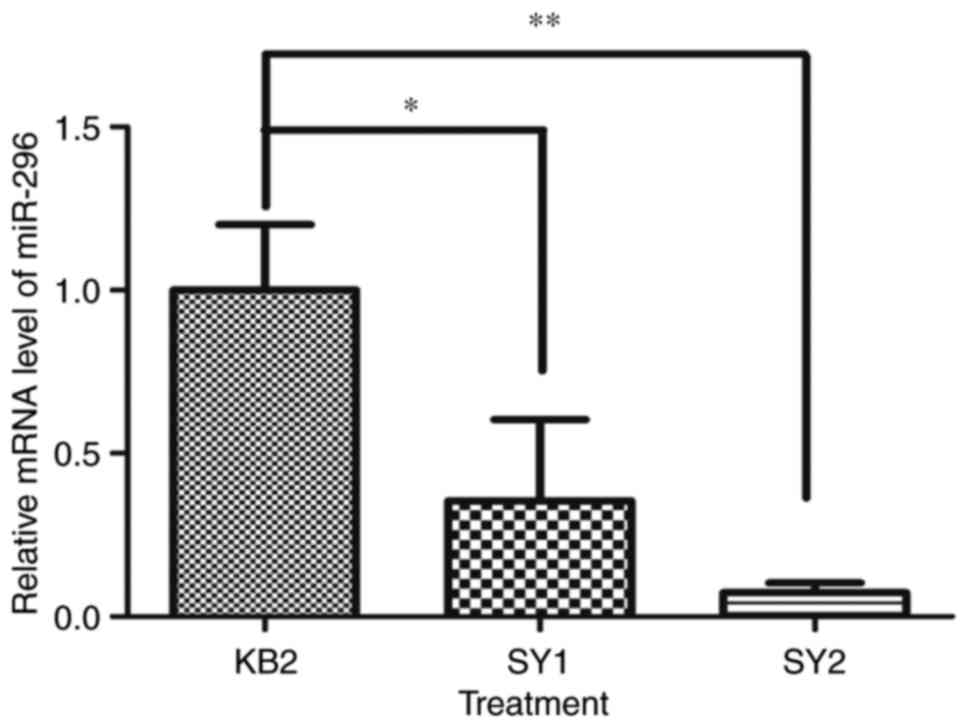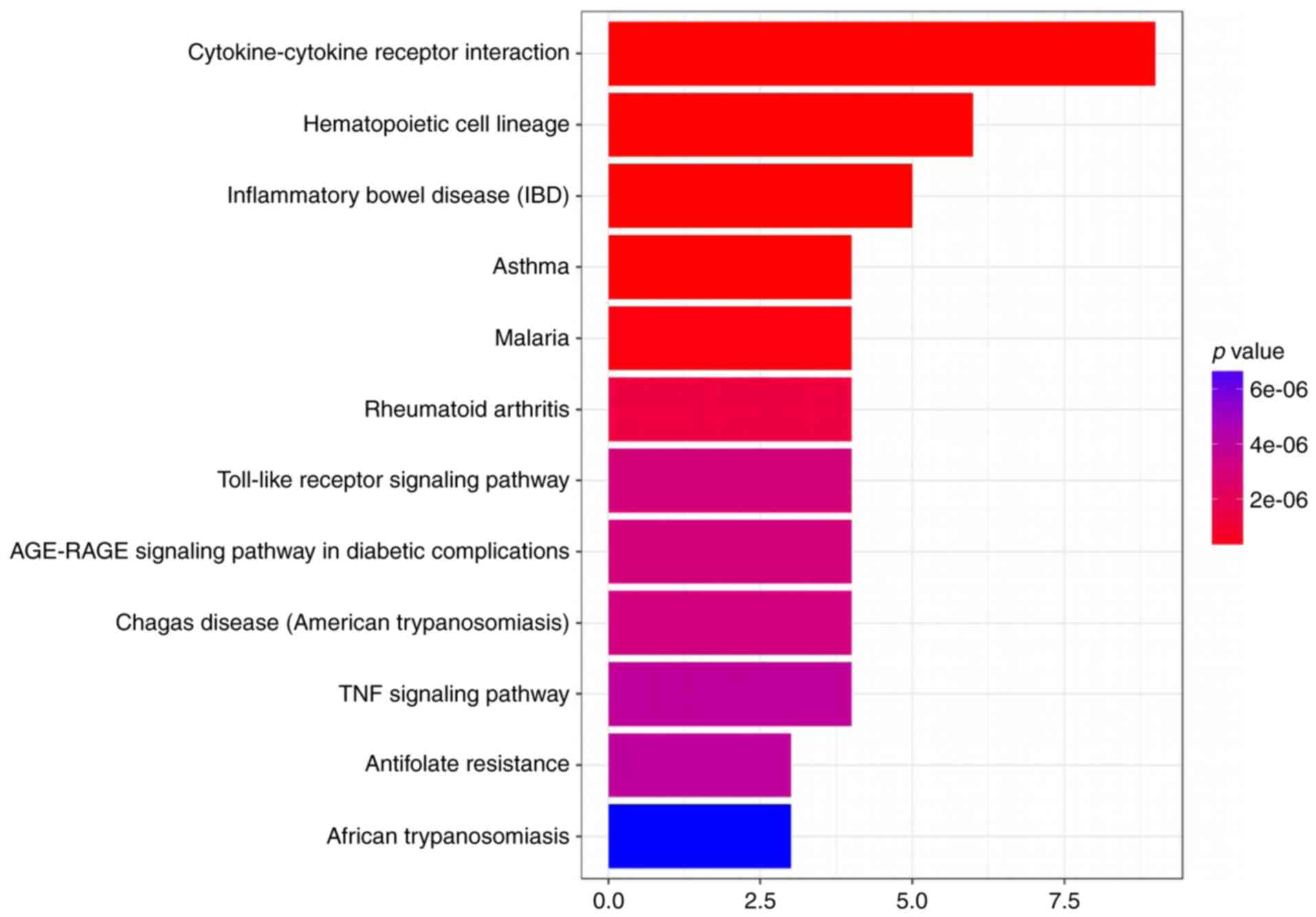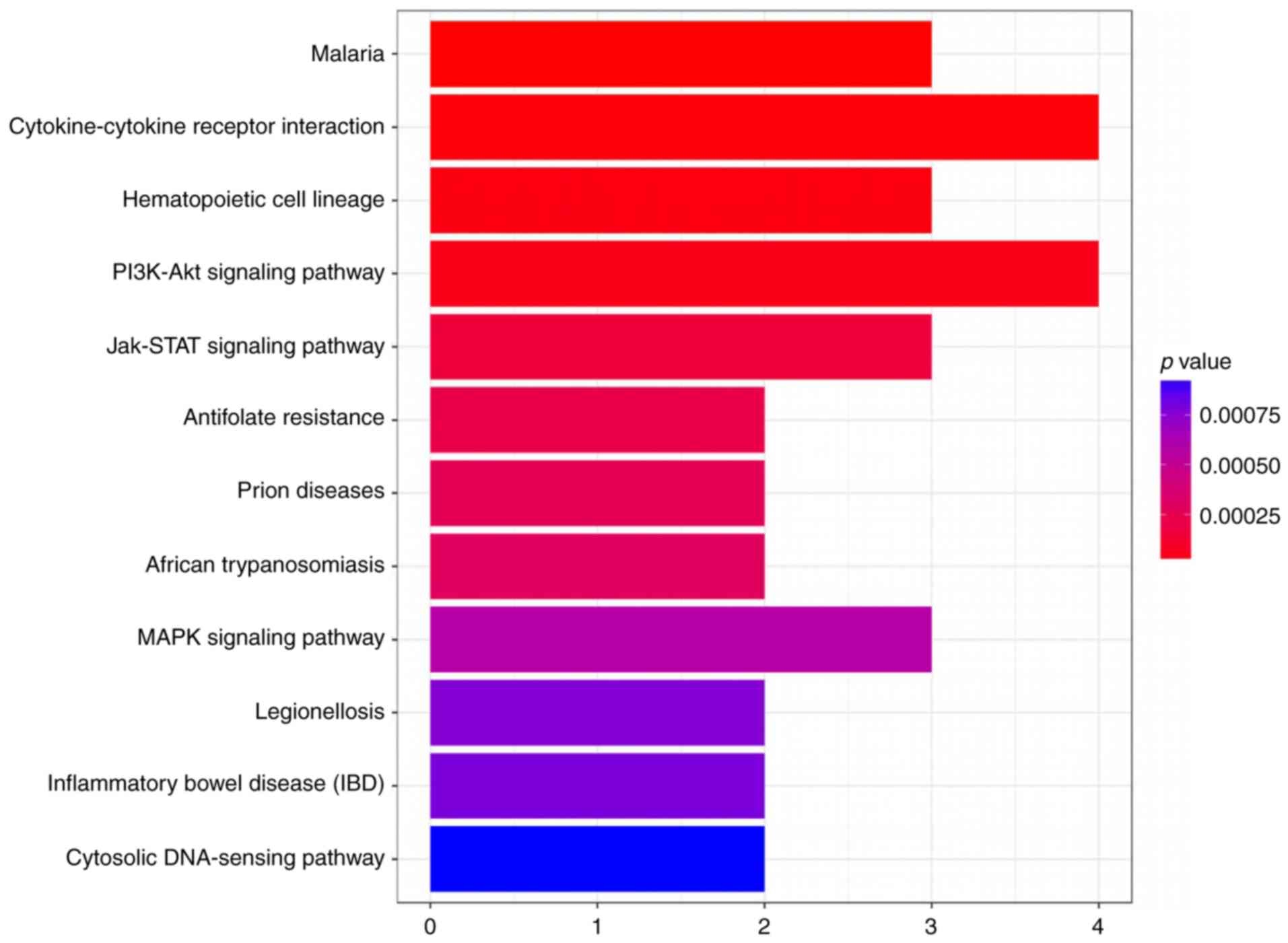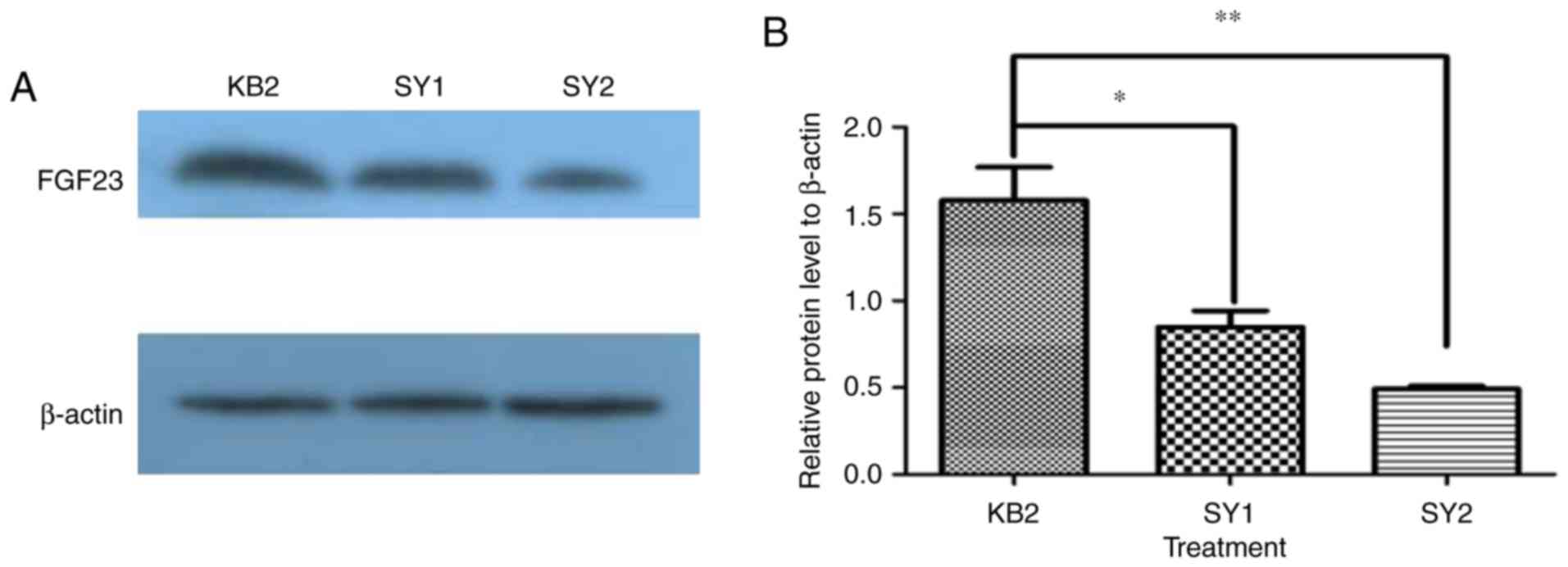MicroRNA-296 mediated corneal neovascularization in an animal model of corneal burns after alkali exposures
- Authors:
- Published online on: October 31, 2017 https://doi.org/10.3892/etm.2017.5408
- Pages: 139-144
-
Copyright: © Ji et al. This is an open access article distributed under the terms of Creative Commons Attribution License.
Abstract
Introduction
Chemical burns are the second most common cause of burns in China (1). According to a previous retrospective study, ocular severe chemical damage leads to devastating injury and accounts for a small but significant percentage of corneal blindness in China (2), for which may be ascribed to the swiftly developing industrialization in Shanghai (3). The failure of appropriate corneal repair following severe eye injuries (such as those after chemical burns) often leads to loss of vision. Alkali burns lead to some of the most serious corneal injuries because alkaline chemicals penetrate tissue more quickly than acids to reach the corneal stroma and extirpate ocular tissues with severe inflammatory response (4,5). Once corneal tissues are damaged by severe chemical burn injuries, corneal neovascularization occurs frequently. The mechanism of corneal neovascularization is thought to involve an imbalance of proangiogenic and anti-angiogenic factors (6,7). Even though corneal neovascularization participates in the pathology of corneal alkali burns, the molecular mechanism of these irreversible injuries is unknown.
MicroRNAs (miRNAs) are highly conserved small noncoding RNAs (consisting of 19 to 25 nucleotides) that can regulate gene transcription in certain kinds of animal and human tissues (8,9). Studies have illustrated that numerous of miRNAs are expressed in mammalian eyes and can display distinctly different expression patterns and molecular functions (10,11). Among them, miR-296 was shown to be associated with angiogenic endothelial cells (12) and prostate cancer cells (13), and with upregulated VEGF and downregulated Notch1 following cerebral ischemic injury (14). However, little is known about miR-296 involvement in the pathophysiology of chemical burns of the cornea.
In the current study, we investigated whether miR-296 participates in the pathobiology of alkali burns in cornea. The results of our study can further our understanding of the underlying molecular mechanisms of this type of ocular pathology, and may help provide novel clinical treatments for patients with corneal alkali burns.
Materials and methods
Animals
Care, use, and treatment of all of the animals utilized in this study were in strict compliance with the Statement for the Use of Animals in Ophthalmic and Vision Research. Male Balb/c mice, 6 to 8 weeks old, were purchased from the Animal Sciences Department of Nanchang University. The mice were maintained on a 12-h light/dark cycle for at least 2 weeks prior to the onset of experiments. All experimental procedures were reviewed and approved by the Ethics Committee for Animal Research at the Second Hospital Affiliated with Nanchang University, Nanchang, China.
Experimental animal model of corneal burns after exposure to alkali
The mice were studied while under general anesthesia induced by intraperitoneal injection of 0.3 ml/kg chloral hydrate, followed by topical anesthesia of the eye by drops of 0.5% proparacaine hydrochloride (Alcon, Inc., Fort Worth, TX, USA). A sheet of filter paper (Sigma-Aldrich; Merck KGaA, Darmstadt, Germany) was cut to size in order to provide disk-shaped pieces with diameters of 2 mm. These filter paper disks were presoaked in 1 N NaOH, and then applied to the center of the anesthetized cornea of the right eye of each mouse for 10 sec, followed by immediate eye irrigation with balanced salt solution (Alcon, Inc.), as previously described (15), and the animals were then randomly allocated to 1 of 3 different treatment groups: Levofloxacin eye drops (KB2), levofloxacin and FK506 eye drops (SY1), or levofloxacin and tobramycin dexamethasone eye drops (SY2).
Total RNA sample preparation and quantitative polymerase chain reaction (qPCR)
To quantify miR-296 mRNA expression levels, frozen mice corneal tissues were dissolved in Trizol (Takara Biotechnology Co., Ltd., Dalian, China) and treated 3 times with liquid nitrogen for 5 min and then a 37°C water bath for 5 min. Total RNA was extracted from the tissues according to the manufacturer's guidelines. Purified total RNA (1 µg) was then reverse transcribed into cDNA using a RevertAid™ First Strand cDNA Synthesis kit (Fermentas; Thermo Fisher Scientific, Inc., Pittsburgh, PA, USA). Specific primers (Table I) were synthesized by Invitrogen; Thermo Fisher Scientific, Inc. Real-time PCR was performed using the TransStart Tip Green qPCR SuperMix system (TransGen Biotech, Beijing, China) using the following conditions: Incubation at 95°C for 10 min, followed by 40 cycles of 15 sec at 95°C and 1 min at 60°C. All samples were tested in triplicate. PCR reactions and the mean of the reactions were used for calculating expression levels. All data were collected from the linear range of amplification. Expression levels were normalized for the average of U6 mRNA levels from the same samples.
KEGG pathway enrichment analysis of differentially expressed proteins
Kyoto Encyclopedia of Genes and Genomes (KEGG) is a database for systematic analysis of gene function, linking genome, and higher order information. This resource facilitates the study of gene and expression data as a whole network. Our study was performed using the KEGG database (http://www.genome.jp/kegg/) (16,17) and Fisher's exact test. We selected the standard as the difference in the number of genes on a term/pathway ≥5, P<0.05. The term/pathway was drawn based on the enrichment factor value from the descending order of size, taking into account the first 12 results.
Western blot analysis
To quantify FGF23 protein expression levels, frozen mouse corneal tissues were dissolved in tissue RIPA lysis buffer containing 50 mM Tris-HCl (pH 7.4); Igepal 1% (w/v); 0.25% (w/v) Na-deoxy cholate; 1 mM EDTA, 150 mM NaCl; 1 µg/ml each of protease inhibitors aprotinin, leupeptin and pepstatin; 1 mM Na3VO4; and 1 mM NaF. Following ultrasonic dispersion, the samples were centrifuged at 12,000 × g for 10 min at 4°C. The supernatant was then collected, and total protein concentration was determined using the Pierce BCA Protein Assay kit (Thermo Fisher Scientific, Inc.). Protein samples of tissues were loaded with an equal volume of 2X SDS-PAGE loading buffer (100 mM Tris-HCl, pH 6.8; 4% SDS; 20% glycerol; 0.2% bromphenol blue and 0.14% β-mercaptoethanol) and boiled (for 5 min at 100°C), and the protein samples were stored at −20°C until use. For immunoblotting, 20 µg of the total protein samples were resolved on 12% SDS-PAGE, at a constant voltage of 100 V for 2 h. The proteins resolved in the gel were then transferred to nitrocellulose membranes (EMD Millipore, Billerica, MA, USA) using Tris/glycine buffer, pH 8.3 (25 mM Tris base, 192 mM glycine, 0.1% w/v SDS, 20% v/v methanol) at 250 to 300 mA for 3 h. The membranes were then blocked for 1 h in non-fat powdered milk (5%) in TBST washing buffer (10 mM Tris, 150 mM NaCl, 0.1% Tween-20), and incubated with the primary antibody of interest overnight at 4°C. Rabbit polyclonal anti-FGF23 (1:200; Wuhan Boster Biological Technology, Ltd., Wuhan, China) were used, and the membranes were then washed in TBS-Tween-20 three times over 15 min and incubated with HRP-conjugated goat anti-rabbit IgG (1:2,000; ZSGB-BIO; OriGene Technologies, Inc., Beijing, China) for 1 h at ambient temperature and washed in TBST washing buffer as above. Immunoreactivity was visualized using film exposure. To allow normalization for minor variances in protein loading between sample lanes, the blots were re-probed for anti-β-actin (1:1,000; ZSGB-BIO; OriGene Technologies, Inc.). ImageJ software (National Institutes of Health, Bethesda, MD, USA) was used to analyze immunoblotting images. Optical densities of all bands were measured with the image background subtracted to give the final densitometry values.
Statistical analysis
The data are presented as mean values ± standard errors. The Kolmogorov-Smirnov test was used to check the normal distribution of the datasets. The one-way analysis of variance (ANOVA) for measurements was performed using GraphPad Prism version 5.0 (GraphPad Software, Inc., La Jolla, CA, USA), with Turkey's post hoc test for multiple comparisons where appropriate. P<0.05 was considered to indicate a statistically significant difference. All experiments were repeated at least three times.
Results
In this study of corneal chemical burn wounds, we found that the expression levels of miR-296 mRNA varied significantly in the different treatment groups of our mouse eye model. The results revealed that the data were normally distributed (P>0.05). There was a statistically significant difference between miR-296 mRNA with KB2, SY1 and SY2, as determined by ANOVA (P<0.01). Turkey's post-hoc test revealed the level of miR-296 mRNA expressed was significantly decreased in SY1 and SY2 compared with KB2 (Fig. 1, P<0.05, P<0.01). No significant difference was seen between SY1 and SY2. This result suggested that the miR-296 gene may be involved in the regulation of the pathophysiology of the alkali-burned cornea, and levofloxacin and tobramycin dexamethasone eye drops (SY2) or levofloxacin eye drops and FK506 eye drops (SY1) were both better than the single-ingredient levofloxacin eye drops for treatment of the alkali-burned cornea. Because we found that miR-296 was actively involved in the reaction to alkali burns, we wondered about the mechanism by which it affects the chemical injury in mouse cornea. Therefore, we evaluated the likely pathways that it might affect utilizing a KEGG pathway analysis (Figs. 2 and 3).
We found that FGF23 protein can be expressed differently after different treatments of the corneal alkali burn model. The results revealed that the data were normally distributed (P>0.05). There was a statistically significant difference between FGF23 protein with KB2, SY1 and SY2, as determined by ANOVA (P<0.01). Turkey's post-hoc test indicated the level of FGF23 protein, in comparison with KB2, was significantly decreased in SY1 and SY2 (Fig. 4, P<0.05, P<0.01). Furthermore, we found that SY2 exhibited lower FGF23 protein expression than SY1, but not significant (Fig. 4, P>0.05). This result demonstrated that FGF23 factors may be involved in the regulation of the burned cornea, and levofloxacin and tobramycin dexamethasone eye drops (SY2) were better than levofloxacin eye drops and FK506 eye drops (SY1) or levofloxacin eye drops (KB2) to modulate the damage in alkali burned cornea. Corneal neovascularization was treatment-dependent with the different eye drops on day 7 after corneal alkali burns. Although all mice developed corneal neovascularization after corneal alkali burn, the SY2 exhibited lower corneal neovascularization area compared to SY1 or KB2 (Fig. 5).
Discussion
Based on the present study, we report for the first time that the miR-296 gene is expressed during the transient inflammatory responses that occur in mouse cornea after alkali burns. More importantly, we found that levofloxacin and tobramycin dexamethasone eye drops (SY2) or levofloxacin eye drops and FK506 eye drops (SY1) were better than levofloxacin eye drops alone to modulate miR-296 gene activity after alkali burns in the mouse eye.
The advantages of employing knowledge base-driven pathway analysis are becoming more and more appreciated by many investigators in medical research, because it can reduce the complexity of functional analysis by grouping thousands of genes into just several hundred pathways. Such analysis can also increase the explanatory power of experimental results by identifying active pathways in different conditions (18). KEGG is an integrated database that is helpful for biological interpretation of genome sequences and other high-throughput data (19,20). In this study, we identified for the first time a candidate for the most important pathway involved in the miR-296 gene-related inflammatory responses in the mouse cornea after alkali burns in the light of KEGG pathway. In addition, we concluded that the most likely overlap pathway was a cytokine-cytokine receptor interaction pathway. Then, we examined the FGF23 protein that participates in the mouse cornea alkali burn and found that SY2 was better than the other formulations (SY1 or KB2) to ameliorate the effects of alkali on the mouse cornea. Corneal neovascularization (CNV) is playing a critical aspect in the pathophysiology of corneal alkali burns. Multistage and distinct molecules contribute to CNV. In corneal diseases, a number of cytokines and growth factors are upregulated and induce infiltration of neutrophils, macrophages, and lymphocytes (21). CNV is also directly related to Macrophages infiltration (22). The current treatments for CNV include corticosteroids and anti-VEGF (22). Dexamethasone, a synthetic corticosteroid, is widely used as a potent anti-inflammatory drug in various diseases including corneal angiogenesis (23). Dexamethasone can not only inhibit IL-1β-induced angiogenesis via blocking NF-κB signaling, but also partially inhibit VEGF-A (24). Dexamethasone has a large therapeutic window. FK-506 (Tacrolimus), an immunosuppressive neutral macrolide, is isolated from streptomyces tsukubaensis (25). A study pointed out FK-506 can suppress VEGF in a rabbit CNV model (22). At present, we firstly compared SY2 with SY1, and we concluded that SY2 is SY2 was better to ameliorate the effects of alkali on the mouse cornea. We also found that the IL6 protein was not expressed in this experimental model. Corneal neovascularization was decreased, but we did not quantify it on day 7 after the alkali burn. Thus, in subsequent research, we aim to investigate the mechanism of miR-296-mediated corneal neovascularization in the mouse model of alkali burns.
Taken together, we investigated the miR-296 gene and a possible pathway involved in the transient inflammatory responses of mouse cornea following experimental trauma from alkali exposure. The insights from this study may lead to new therapeutic strategies for treatment corneal alkali burns in the clinical setting.
Acknowledgements
This study was supported by Natural Science Foundation of Jiangxi (grant no. 20161BAB205270).
References
|
Xie Y, Tan Y and Tang S: Epidemiology of 377 patients with chemical burns in Guangdong province. Burns. 30:569–572. 2004. View Article : Google Scholar : PubMed/NCBI | |
|
Zhang C and Xu J: Indications for penetrating keratoplasty in East China, 1994–2003. Graefes Arch Clin Exp Ophthalmol. 243:1005–1009. 2005. View Article : Google Scholar : PubMed/NCBI | |
|
Hong J, Qiu T, Wei A, Sun X and Xu J: Clinical characteristics and visual outcome of severe ocular chemical injuries in Shanghai. Ophthalmology. 117:2268–2272. 2010. View Article : Google Scholar : PubMed/NCBI | |
|
Saika S, Kobata S, Hashizume N, Okada Y and Yamanaka O: Epithelial basement membrane in alkali-burned corneas in rats. Immunohistochemical study. Cornea. 12:383–390. 1993. View Article : Google Scholar : PubMed/NCBI | |
|
Ishizaki M, Zhu G, Haseba T, Shafer SS and Kao WW: Expression of collagen I, smooth muscle alpha-actin, and vimentin during the healing of alkali-burned and lacerated corneas. Invest Ophthalmol Vis Sci. 34:3320–3328. 1993.PubMed/NCBI | |
|
Pandya NM, Dhalla NS and Santani DD: Angiogenesis-a new target for future therapy. Vascul Pharmacol. 44:265–274. 2006. View Article : Google Scholar : PubMed/NCBI | |
|
de Groot H, Schmit-Eilenberger V, Kirchhof J and Augustin AJ: Angiostatic and angiogenic factors. Dev Ophthalmol. 46:1–3. 2010. View Article : Google Scholar : PubMed/NCBI | |
|
Ambros V: The functions of animal microRNAs. Nature. 431:350–355. 2004. View Article : Google Scholar : PubMed/NCBI | |
|
Ranganathan K and Sivasankar V: MicroRNAs-Biology and clinical applications. J Oral Maxillofac Pathol. 18:229–234. 2014. View Article : Google Scholar : PubMed/NCBI | |
|
Ryan DG, Oliveira-Fernandes M and Lavker RM: MicroRNAs of the mammalian eye display distinct and overlapping tissue specificity. Mol Vis. 12:1175–1184. 2006.PubMed/NCBI | |
|
Karali M, Peluso I, Gennarino VA, Bilio M, Verde R, Lago G, Dollé P and Banfi S: miRNeye: A microRNA expression atlas of the mouse eye. BMC Genomics. 11:7152010. View Article : Google Scholar : PubMed/NCBI | |
|
Würdinger T, Tannous BA, Saydam O, Skog J, Grau S, Soutschek J, Weissleder R, Breakefield XO and Krichevsky AM: miR-296 regulates growth factor receptor overexpression in angiogenic endothelial cells. Cancer Cell. 14:382–393. 2008. View Article : Google Scholar : PubMed/NCBI | |
|
Wei JJ, Wu X, Peng Y, Shi G, Basturk O, Yang X, Daniels G, Osman I, Ouyang J, Hernando E, et al: Regulation of HMGA1 expression by microRNA-296 affects prostate cancer growth and invasion. Clin Cancer Res. 17:1297–1305. 2011. View Article : Google Scholar : PubMed/NCBI | |
|
Feng J, Huang T, Huang Q, Chen H, Li Y, He W, Wang GB, Zhang L, Xia J, Zhang N and Liu Y: Pro-angiogenic microRNA-296 upregulates vascular endothelial growth factor and downregulates Notch1 following cerebral ischemic injury. Mol Med Rep. 12:8141–8147. 2015. View Article : Google Scholar : PubMed/NCBI | |
|
Bian F, Pelegrino FS, Henriksson JT, Pflugfelder SC, Volpe EA, Li DQ and de Paiva CS: Differential effects of dexamethasone and doxycycline on inflammation and MMP production in alkali-burned corneas associated with dry eye. Ocul Surf. 14:242–254. 2016. View Article : Google Scholar : PubMed/NCBI | |
|
Draghici S, Khatri P, Tarca AL, Amin K, Done A, Voichita C, Georgescu C and Romero R: A systems biology approach for pathway level analysis. Genome Res. 17:1537–1545. 2007. View Article : Google Scholar : PubMed/NCBI | |
|
Kanehisa M, Goto S, Kawashima S, Okuno Y and Hattori M: The KEGG resource for deciphering the genome. Nucleic Acids Res. 32(Database issue): D277–D280. 2004. View Article : Google Scholar : PubMed/NCBI | |
|
Du J, Li M, Yuan Z, Guo M, Song J, Xie X and Chen Y: A decision analysis model for KEGG pathway analysis. BMC Bioinformatics. 17:4072016. View Article : Google Scholar : PubMed/NCBI | |
|
Kanehisa M, Sato Y, Kawashima M, Furumichi M and Tanabe M: KEGG as a reference resource for gene and protein annotation. Nucleic Acids Res. 44:D457–D462. 2016. View Article : Google Scholar : PubMed/NCBI | |
|
Khatri P, Sirota M and Butte AJ: Ten years of pathway analysis: Current approaches and outstanding challenges. PLoS Comput Biol. 8:e10023752012. View Article : Google Scholar : PubMed/NCBI | |
|
Wilson SE, Mohan RR, Mohan RR, Ambrósio R Jr, Hong J and Lee J: The corneal wound healing response: Cytokine-mediated interaction of the epithelium, stroma, and inflammatory cells. Prog Retin Eye Res. 20:625–637. 2001. View Article : Google Scholar : PubMed/NCBI | |
|
Park JH, Joo CK and Chung SK: Comparative study of tacrolimus and bevacizumab on corneal neovascularization in rabbits. Cornea. 34:449–455. 2015. View Article : Google Scholar : PubMed/NCBI | |
|
Nakao S, Hata Y, Miura M, Noda K, Kimura YN, Kawahara S, Kita T, Hisatomi T, Nakazawa T, Jin Y, et al: Dexamethasone inhibits interleukin-1beta-induced corneal neovascularization: Role of nuclear factor-kappaB-activated stromal cells in inflammatory angiogenesis. Am J Pathol. 171:1058–1065. 2007. View Article : Google Scholar : PubMed/NCBI | |
|
Nakao S, Zandi S, Lara-Castillo N, Taher M, Ishibashi T and Hafezi-Moghadam A: Larger therapeutic window for steroid versus VEGF-A inhibitor in inflammatory angiogenesis: Surprisingly similar impact on leukocyte infiltration. Invest Ophthalmol Vis Sci. 53:3296–3302. 2012. View Article : Google Scholar : PubMed/NCBI | |
|
Yuan J, Zhai JJ, Chen JQ, Ye CT and Zhou SY: Preparation of 0.05% FK506 suspension eyedrops and its pharmacokinetics after topical ocular administration. J Ocul Pharmacol Ther. 25:345–350. 2009. View Article : Google Scholar : PubMed/NCBI |














